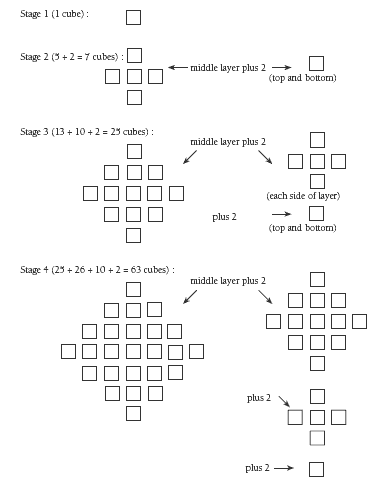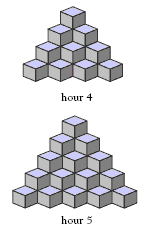Crazy Cubes
This is a level 3 geometry activity from the Figure it Out series.
A PDF of the student activity is included.
Click on the image to enlarge it. Click again to close. Download PDF (318KB)
interpret and draw representations of cube patterns
identify the pattern in a series of cube buildings
multilink cubes
Copymaster of isometric paper
FIO, Level 3-4, Geometry, Crazy Cubes, page 4
Activity One
This activity requires students to view 3-dimensional models made from multilink cubes, make the models, and practise drawing models on isometric paper (see the copymaster at the end of these notes). Drawing the models on isometric paper is quite a challenging task, but it follows on from the activities on pages 6 and 10 in Geometry, Figure It Out, Level 3.
If the students record their findings for question 1 on a chart as shown in the Answers, it makes it easier for them to look for patterns and to predict the next model in the sequence. As noted in the answer for question 3, the difference generates triangular numbers. (This activity connects to the Algebra strand.)
Activity Two
Some students may have difficulty working out the various layers of the isometric drawing in this activity. The following diagram of the layers may help.
Stage 5 will be 41 + 50 + 26 + 10 + 2, and so on.
As an extension, the students could also use the models in both activities to draw views from different perspectives such as the front, top, and side. This task can help them to visualise and draw 3-dimensional models. It also makes them realise that cubes can be part of a model but cannot always be seen in a drawing. Alternatively, given a drawing of different views, the students could create the 3-dimensional model.
Answers to Activity
Activity One
1. Practical activity. A table is a good way to organise the information:
2. a. Practical activity. The crystal should look like this:
b. The crystal has 20 cubes at hour 4 and 35 cubes at hour 5.
3. When the crystal is made with cubes, the difference between the number of cubes in each stage is a triangular number.
So a note to Cecily could read:
Dear Cecily
The crystal pattern is growing a little more each hour. In the first hour, the crystal grew by three cubes. In the next hour, the crystal grew by six more cubes, then by 10, and then by 15. I think the pattern is triangular.
Yours sincerely
signed
Activity Two
1. Practical activity
2. 63



